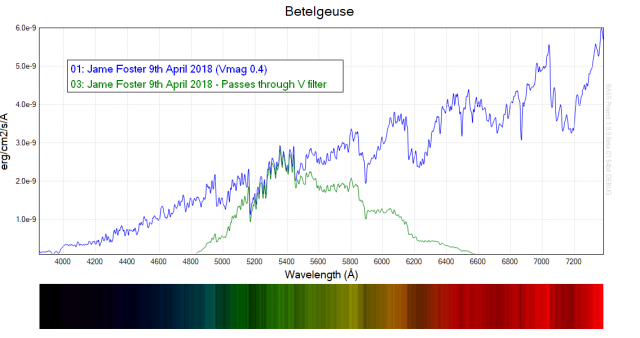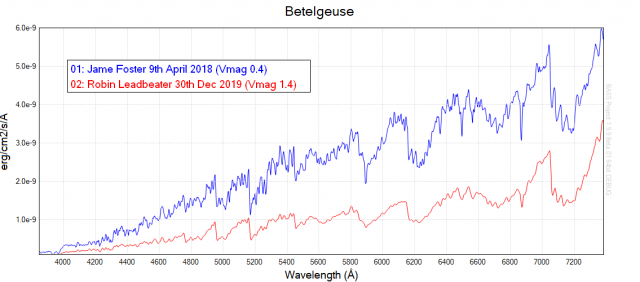› Forums › General Discussion › Betelgeuse › Has luminosity shifted into the IR?
Betelgeuse is a cool red star with the majority of its flux in the red and infrared, while the majority of observations are visual or with a V filter. It occurred to me the widely discussed drop in luminosity is based on the assumption that what is happening in the visual represents the total luminosity of the star, and this might not be the case. I decided to do a little investigation using spectra from the BAA Spectroscopy Database and V filter magnitudes from the AAVSO International Database to do a rough flux calibration of the spectra.
My first plot shows what passes through a V filter using James Foster’s spectrum from 9th April 2018. You can see the V filter is most sensitive to wavelengths where Betelgeuse is not at its brightest. The V filter is approximately like human vision, not a perfect match but reasonable. You can also see how the flux continues to rise to shorter wavelengths towards the infrared.

Next I compared James Foster’s spectrum from 9th April 2018 to Robin Leadbeater’s recent spectrum from 30th December 2019. The approximate V magnitudes on these dates are 0.4 and 1.4, though due to difficulties with measuring the luminosity of Betelgeuse it is best to consider these with uncertainties of +/-0.1 magnitudes. A magnitude of 0.4 is fairly typical of Betelgeuse in recent years, noting it regularly varies by nearly a magnitude. I did a flux calibration using the V filter profile rather than any specific representative wavelength. This was to avoid any effects due to individual lines skewing the results. This shows a very marked drop in luminosity to longer wavelengths up to at least 7400 Angstroms.

Their aren’t spectra in the BAA database with longer wavelengths into the infrared due to the difficulty in making these measurements. So instead I then compared Pickles reference spectra for M2 and M4 (both at luminosity class III). These aren’t perfect matches to James and Robin’s spectra but they are good enough for a first approximation (M2 typical and M4 now). It can be seen that a drop in luminosity at shorter wavelengths in the visual region does not necessary continue to longer wavelengths, with the flux being about the same from about 8000 Angstroms. These spectra only go to 10,000 Angstroms, but give a hint of stronger flux deeper into the infrared for the cooler M4 spectrum. So I wonder whether the total luminosity has not dropped by as much as it appears. Perhaps some or most of the flux has shifted from the visual into the infrared?

Comments and criticism welcome 🙂
